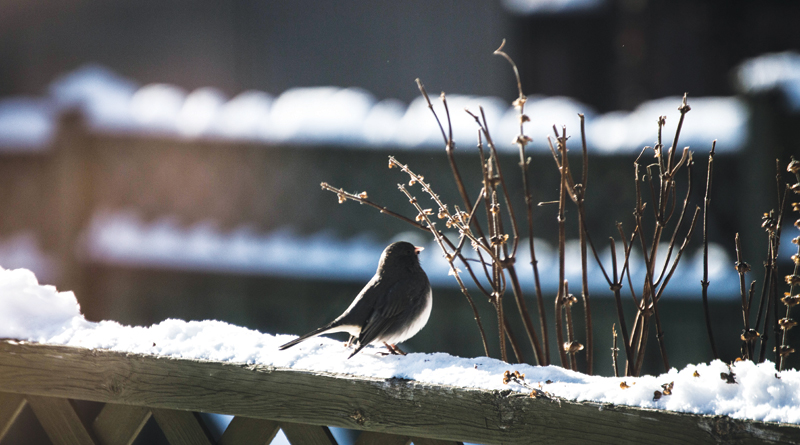WHERE ARE THE WINTER BIRDS? – Life In The Outdoors

Dark-eyed juncos and tree sparrows fly back and forth to the bird feeder outside my dining room window every day now, except when the wind is strong and the weather especially wintry. They’re winter visitors, birds from northern Canada. On the feeder they join birds that come to the feeder in summer and winter, black-capped chickadees, tufted titmice, white-breasted nuthatches, down woodpeckers, cardinals and blue jays.
Juncos and tree sparrows, two of each, at least that’s all I’ve seen, are the only winter birds I’ve seen this winter at my feeder, or anywhere. Where are the evening grosbeaks, the pine siskins, the common redpolls and purple finches? Where are the cross bills I’ve seen occasionally in other winters in the wooded park near my home? Where are the flocks of snow buntings in pastures and other grassy fields?
Evening grosbeaks were once common winter birds in the northern states of the U.S. When I was at Cornell University, many years ago, I helped a lady who was studying evening grosbeaks. We trapped and banded them one winter. After I moved to Indiana small flocks of evening grosbeaks came to my bird feeders in winter several times. I haven’t seen an evening grosbeak, except in summer when I visited their northern nesting grounds,
since I lived and worked at Salamonie Reservoir, south of Huntington, Indiana nearly twenty years ago.
Pine siskins competed with goldfinches every winter for seed at the thistle feeders I had under the eaves of my home at Salamonie. I saw redpolls and purple finches and crossbills in wooded areas around Salamonie, flocks of snow buntings occasionally. Like evening grosbeaks I haven’t seen snow buntings in years though I’ve had people tell me of seeing them.
Warblers have declined. These little feathered sprites, many of them quite colorful, migrate in flocks and in spring to be in a woods early in the morning when a flock of warblers had landed and were feeding after flying most of the night was a delight and a pain. It was a pain in the neck from looking through binoculars into the leaves overhead, trying to spot those little birds. A woods full of warblers was called a warbler wave and a morning of spotting them often led to a condition which birds called warbler neck.
While most warblers have declined, Kirtland’s warblers have increased. One of the first species of birds to be listed under the Endangered Species Act it has increased from approximately 200 pairs to over 2,000 and was recently taken off the Endangered Species list.
Birds of North America, and South America and many other areas of the world have declined. Not all species have declined. Bald eagles, Canada geese, Sandhill cranes, turkey vultures, California condors and wild turkeys have increased. Cardinals, tufted titmice and turkey vultures have increased and extended their range north. Starlings and house sparrows may not have increased but they certainly haven’t declined.
Why have so many species of birds of North America, and South America and many other areas of the world, declined? There is no one cause. Global warming is certainly one factor. Change of land use, clearing of wooded areas and fence rows and subsequent larger open fields is another, use of chemicals is another, more people and expanding urban areas is another.
Birds have declined in number. I read a report recently that they have changed in size too, that they have gotten slightly smaller. Bird watching, birding, is still looking for birds, learning to identify different species. It’s also noting numbers.
Bird watching remains a pleasant way to spend an hour, a few hours, a day, to get away from the problems, the pressure of normal live.
- Birds As Weather Forecasters – Life In The Outdoors - December 17, 2021
- Rare Bird Spotted In Indiana – Life In The Outdoors - October 8, 2021
- MY EXPERIENCE WITH DEER – Life In The Outdoors - July 30, 2021


